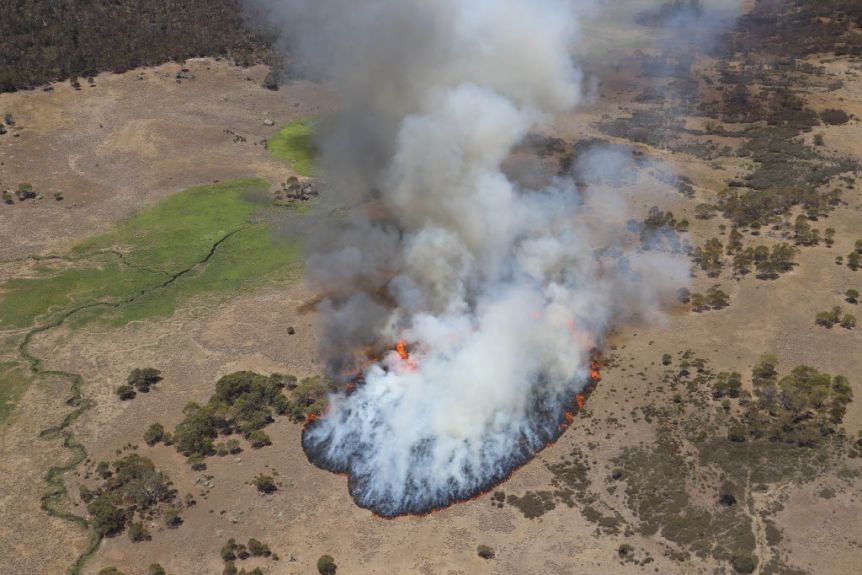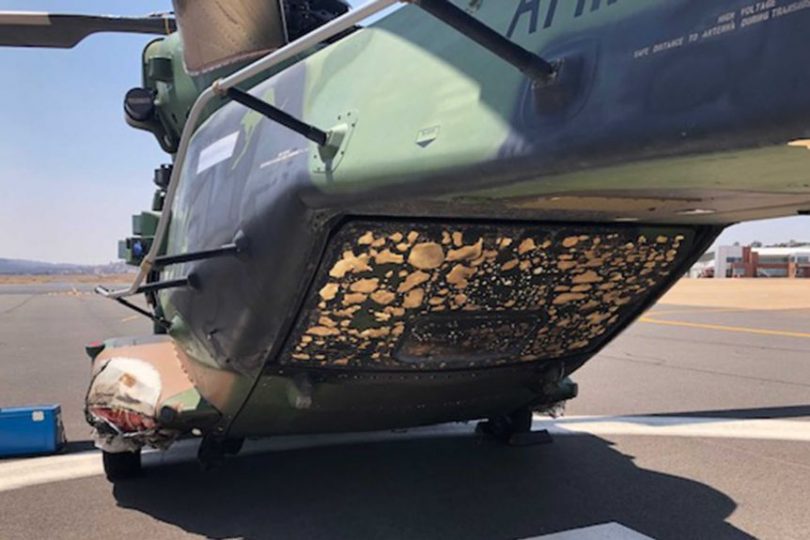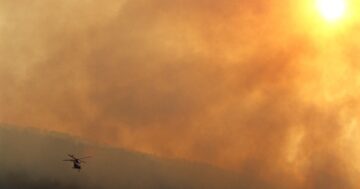
Photos of the start of the Orroral Valley fire taken from the helicopter which accidentally started it. Photo: Department of Defence via ABC.
The co-pilot and captain of the Army helicopter, which accidentally ignited the Orroral Valley fire, told an inquest into the incident that the aircraft and their crew’s safety came ahead of reporting the blaze.
Senior counsel assisting Kylie Nomchong SC spent Tuesday morning (6 June) continuing to question the Army member known as ‘Witness D2’ in the ACT Coroner’s Court about why they did not report the January 2020 fire caused by heat from the helicopter’s searchlight when it landed in the Orroral Valley for a toilet break, until they arrived at Canberra Airport 17 minutes after accidentally starting the blaze.
Ms Nomchong produced an Army document listing “reputation” second on a list of ‘officer commanding priorities’ and separately suggested that Witness D2 did not seek to communicate information about the fire earlier because they did not want to damage Defence’s reputation. Witness D2 rejected this suggestion as the helicopter’s other co-pilot, Witness D1, had also previously done in November 2022.
“Weren’t you embarrassed or ashamed or guilty?” Ms Nomchong continued.
Witness D2 replied, “Not one bit of me was considering reputation at that stage.”
Witness D2 said they phoned another Defence member after landing at Canberra Airport and said, “We’ve started a fire”, and provided its coordinates with the understanding that information would be passed on.
The inquest heard the aircraft previously had about 10 exchanges with Canberra Airport on its flight there and crew members, including Witness D2, were communicating information about the incident using the encrypted messaging application Signal.
“A21 pan pan, Enroute [to] cb [Canberra] in contact with atc [Air Traffic Control]. External fire damage to [sic]. Landing cb [Canberra] in 2 [minutes],” Witness D2 wrote.
“No cas [casualties] or anything.”
Witness D2 agreed they knew the fire, which burned for one month and covered 78 per cent of Namadgi National Park and 22 per cent of the Tidbinbilla Nature Reserve, was serious in the context of the 2019-20 bushfire season but maintained throughout the hearing that they had been actively “managing an aircraft emergency” during the return flight and their “capacity was basically dedicated to the aircraft safety”.
The inquest heard smoke and fumes were inside the helicopter at one stage. Witness D2 said the aircraft’s situation was “evolving” and a safe landing was not confirmed until it had taken place.
As captain of the aircraft, Witness D2 was responsible for the five others on board, including the other co-pilot (Witness D1), two aviation crew members and two others taking photographs and notes.
Ms Nomchong put it to Witness D2 that there were also emergency services personnel on the ground, which Witness D2 admitted knowing about but said they were unaware of their proximity to the fire.
When Ms Nomchong asked Witness D2 if they were aware of the potential danger the fire posed to the ground personnel, they said, “That is, I suppose, an accurate deduction to make”.
Ms Nomchong pressed, “You didn’t think about the people on the ground?” Witness D2 said the ground personnel would have been their “first priority” if not for the aircraft’s condition.

The damage sustained on the helicopter that accidentally ignited the Orroral Valley fire. Photo: Department of Defence via ABC.
Not long afterwards, ACT chief coroner Lorraine Walker directly asked Witness D2, “Did it not enter your head [to address other issues aside from the aircraft’s safety]?”
Witness D2 responded that ensuring the safety of the helicopter was a “full-time job”, and they were not thinking of “what was happening 10 miles behind me”.
The inquest heard another aircraft was in a similar area around the same time, which the helicopter crew similarly did not seek to notify of the fire.
Witness D2 said they understood the aircraft had departed the area as they had not heard from its crew on the radio for some time.
Ms Nomchong also pressed Witness D2 on reporting protocols, including notifying their squadron operations cell, Two Alpha, of when and where they landed or took off.
Witness D2 said this requirement only related to their tasks or activities believed to affect those tasks, which is why they did not report their impromptu landing in the Orroral Valley.
Ms Nomchong suggested reporting the incident also fell within the types of incidents described by a reporting requirements directive issued about a fortnight before the incident.
Witness D2 agreed but said “short-term risk minimisation” had to occur before compliance and that reporting the incident before taking the “right action” would have increased risk.
Asked whether they were exercising their own judgement or acting on something the Army had taught them when making that decision, Witness D2 responded it was the latter.
Witness D2 said they might do “additional things” with hindsight, but their prioritisation of the aircraft’s safety would remain unchanged if the situation repeated itself.













